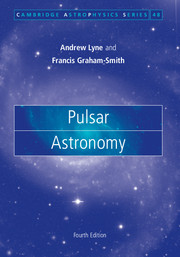Book contents
- Frontmatter
- Contents
- List of illustrations
- Preface
- 1 The discovery of pulsars
- 2 Neutron stars
- 3 Telescopes and techniques
- 4 The distances of the pulsars
- 5 Pulsar timing
- 6 Timing and astrometry of binary pulsars
- 7 Timing irregularities
- 8 The Galactic population of pulsars
- 9 The Crab and Vela Pulsars
- 10 Other young pulsars
- 11 Millisecond and binary pulsars
- 12 Accretion-powered X-ray pulsars
- 13 Magnetars
- 14 Supernovae and their remnants
- 15 Integrated pulse profiles
- 16 Individual pulses
- 17 Location of emitting regions
- 18 Radiation processes
- 19 The emission mechanisms
- 20 Interstellar scintillation and scattering
- 21 The interstellar magnetic field
- 22 Achievements and prospects
- References
- Index
4 The distances of the pulsars
Published online by Cambridge University Press: 05 March 2012
- Frontmatter
- Contents
- List of illustrations
- Preface
- 1 The discovery of pulsars
- 2 Neutron stars
- 3 Telescopes and techniques
- 4 The distances of the pulsars
- 5 Pulsar timing
- 6 Timing and astrometry of binary pulsars
- 7 Timing irregularities
- 8 The Galactic population of pulsars
- 9 The Crab and Vela Pulsars
- 10 Other young pulsars
- 11 Millisecond and binary pulsars
- 12 Accretion-powered X-ray pulsars
- 13 Magnetars
- 14 Supernovae and their remnants
- 15 Integrated pulse profiles
- 16 Individual pulses
- 17 Location of emitting regions
- 18 Radiation processes
- 19 The emission mechanisms
- 20 Interstellar scintillation and scattering
- 21 The interstellar magnetic field
- 22 Achievements and prospects
- References
- Index
Summary
The distances of the nearest stars can be obtained from their parallax, which is the apparent annual cyclic movement of position due to the Earth's orbital motion round the Sun. At distances greater than about 1 kiloparsec, stellar distances may be inferred from their apparent brightnesses, since the absolute brightness of a star is generally available from its spectral type. The distances of some of the closest neutron stars and pulsars may similarly be obtained from measurements of parallax, with accuracies comparable to the best optical measurements of other stars. A new and remarkably accurate measurement of kinematic or dynamical distances is available from accurate timing of pulses from some millisecond pulsars, and also from the orbital periods of some binary pulsars.
The observed intensity of a pulsar, in contrast to that of a visible star of known type, is of little use as an indicator of distance, since the intrinsic luminosity is a variable quantity, both from time to time and from pulsar to pulsar. Fortunately, we have available a remarkably direct measurement of distance instead, due to the frequency dispersion of the group velocity of radio waves in the ionised interstellar medium, which leads to an easily measurable frequency-dependent delay in pulse arrival time for all radio pulsars. The magnitude of this delay is directly proportional to the integrated column density of free electrons along the line of sight (see Section 3.11).
- Type
- Chapter
- Information
- Pulsar Astronomy , pp. 49 - 60Publisher: Cambridge University PressPrint publication year: 2012

